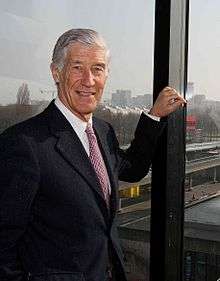Joël de Rosnay
Joël de Rosnay, (born 12 June 1937) is Docteur ès Sciences and scientific writer, presently President of Biotics International,[1] a consulting company specialized in the impact of new technologies on industries, and Special Advisor to the President of the Universcience (Cité des Sciences et de l'Industrie at La Villette et Palais de la Découverte) of which he was Director of Forecasting and Assessment until June 2002.

Biography
From 1975 to 1985 he was Director of Research Applications at l'Institut Pasteur (the Pasteur Institute in Paris). Former research associate at the Massachusetts Institute of Technology (MIT) in the field of biology and computer graphics, he was successively Scientific Attaché to the French Embassy in the United States, and Scientific Director of European Enterprises Development Company (a venture capital group) from 1971 to 1975.
As well as several reports, namely : Biotechnologies and Bio Industry (1979), an annex to the report Sciences de la vie et Société by Professors Gros, Jacob and Royer. He was also co-responsible for the report which led to the creation of CESTA (Centre d'Etudes des Systèmes et des Technologies Avancées / Center for the study of systems and advanced technologies, 1982).
As author
De Rosnay is particularly interested in advanced technologies and the applications of system theory; his concept of the macroscope, a "big picture" view of the globe and its residents, was published in 1975. On these subjects, he wrote :
- Le Macroscope (1975);
- Les Chemins de la Vie (The paths of life) (1983) and
- Le Cerveau Planétaire (The planetary brain) (1986).
De Rosnay wrote for several years on new technologies for the economic magazine L'Expansion. He speaks on the same subject for Europe1, a radio network. De Rosnay is the author of several scientific books aimed at a wider public, such as:
- Les origines de la vie, (The origins of life) (1966);
- La malbouffe (the wrong food) (1979);
- La Révolution Biologique, (the biological revolution) (1982);
- Branchez-vous (Plug-in!), (1984), a book on personal computers;
- L'Aventure du Vivant (The adventure of life) (1988);
- L'avenir en direct (Live from the future) (1989);
- Les rendez-vous du Futur (Rendez-vous with the future) (1991);
- L'Homme Symbiotique, regards sur le 3eme millénaire (The Symbiotic Man, a look into the third millennium) (1995);
- La plus belle histoire du monde, (The most beautiful history of the World) with Yves Coppens, Hubert Reeves and Dominique Simonnet, Seuil, 1996;
- Une vie en plus with Jean-Louis Servan-Schreiber, François de Closets and Dominique Simonnet, Seuil 2005;
- La révolte du Prolétariat with the collaboration of Carlo Revelli, Fayard, 2006.
- 2020 : Les scénarios du futur, Fayard, 2008.
- Surfer la Vie, Sur-Vivre dans la société fluide, LLL, May 2012;
- Je cherche à comprendre...les codes cachés de la nature LLL, 2016;
- La Symphonie du vivant, comment l'épigénétique va changer votre vie, LLL, 2018.
De Rosnay’s ideas have inspired various technology businesses and modern cultural works by creatives, entrepreneurs, and academics, notably around his notion of the cybiont. In The Symbiotic Man, De Rosnay defines a unit of a wholistic social structure, expanding on the concept of the singular living holobiont to also include the totality of human-made machines. He terms this set the cybiont - an emerging “planetary macro-organism” of biological and synthetic entities, all operating in synchrony as a cybernetic system[2][3].
Awards
Joël de Rosnay is laureate of the Prize of the Scientific Information 1990 of the Academy of Sciences and the Benjamin Constant Prize of the Arts of Communication 1994 of the Society of Encouragement of National Industry. He was elected "Digital Personality of the Year 2012" by Acsel (Association for the Digital Economy). On March 12, 2018 he rose to the rank of Grand Commander of the Order of the Star and Key of the Indian Ocean (GCSK) by the Republic of Mauritius for his contribution to the field of research and the environment.
Personal life
De Rosnay's wife Stella is the daughter of Gladwyn Jebb, 1st Baron Gladwyn. His daughter is novelist Tatiana de Rosnay.
De Rosnay is famous for pioneering surfing in France in 1957[4] and created the Surf Club de France[5] in 1964.
References
- Internet site Biotics International
- Lázár, Imre, 1957-. "Attached Files" : anthropological essays on body. ISBN 1-4438-7223-7. OCLC 936413723.CS1 maint: multiple names: authors list (link)
- HEYLIGHEN, Francis (2017). Conceptions of a Global Brain: an historical review. Pleinlaan 2, B-1050 Brussels, Belgium: CLEA, Free University of Brussels.CS1 maint: location (link)
- History of surfing in France
- Surf Club de France
External links


- Crossroads to the future
- Joël de Rosnay interviewed by Denis Failly for his book La Révolte du pronetariat (in French)
- La Révolte du pronetariat index (in French)
- Joël de Rosnay talks about surfing Video on YouTube (in French)